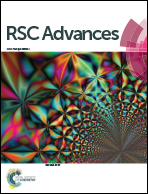Macromolecular chain structure design, synthesis and analysis of poly(l-lactide) linking ultraviolet absorbing groups
Abstract
Poly(L-lactide) (PLA) with different chain structures was designed, and successfully synthesized by ring opening polymerization using 2-hydroxy-4-(3-methacryloxy-2-hydroxylpropoxy) benzophenone (BPMA), 2,2′-dihydroxy-4,4′-(2-hydroxylpropoxy) dibenzophenone (DHDBP) and 2-hydroxy-4-(2,3-dihydroxylpropoxy) benzophenone (HPBP) as initiators, respectively, to produce corresponding PLA-B (end-capped with BPMA), PLA-DB (end-capped with DHDBP) and PLA-HB-PLA (blocked with HPBP in the middle). High-molecular-weight PLA-DB400 with good visible light transparency and UV opacity was prepared. The chemical structures of the samples were characterized, the crystallization behavior, thermal stability, UV absorption properties and transmittance of PLA were investigated and analyzed. Results of GPC and DSC reveal that when the number average molecular weights (Mn) of PLA are around 4000, termination of a UV absorbing group like DHDBP greatly restricts the crystallization of PLA due to the larger volume and rigidity of the end-capping group, but increasing Mn to about 12 000 or higher weakens the hindering effect, resulting in a similar degree of crystallization (Xc). TG results show that PLA-DB400 has the best thermal stability due to the highest molar mass. When the UV absorber is blocked in the PLA chain, the restriction and steric hindrance of the absorber are much stronger than that in the end-capped material, making Xc significantly reduced. UV absorbance of the PLA solutions reveals that the introduction of UV absorbing groups gives an absorption to UV light below 350 nm and the position of the introduced groups has no influence on the UV absorption properties although the content of the UV group does enhance the UV absorbance, of which PLA-DB has the highest since DHDBP bears two 2-dihydroxybenzophenone groups. The transparency of PLA films is neither affected by position nor content of the introduced UV absorbing groups, which is very beneficial for the application of PLA in packaging materials that require high transparency.


 Please wait while we load your content...
Please wait while we load your content...